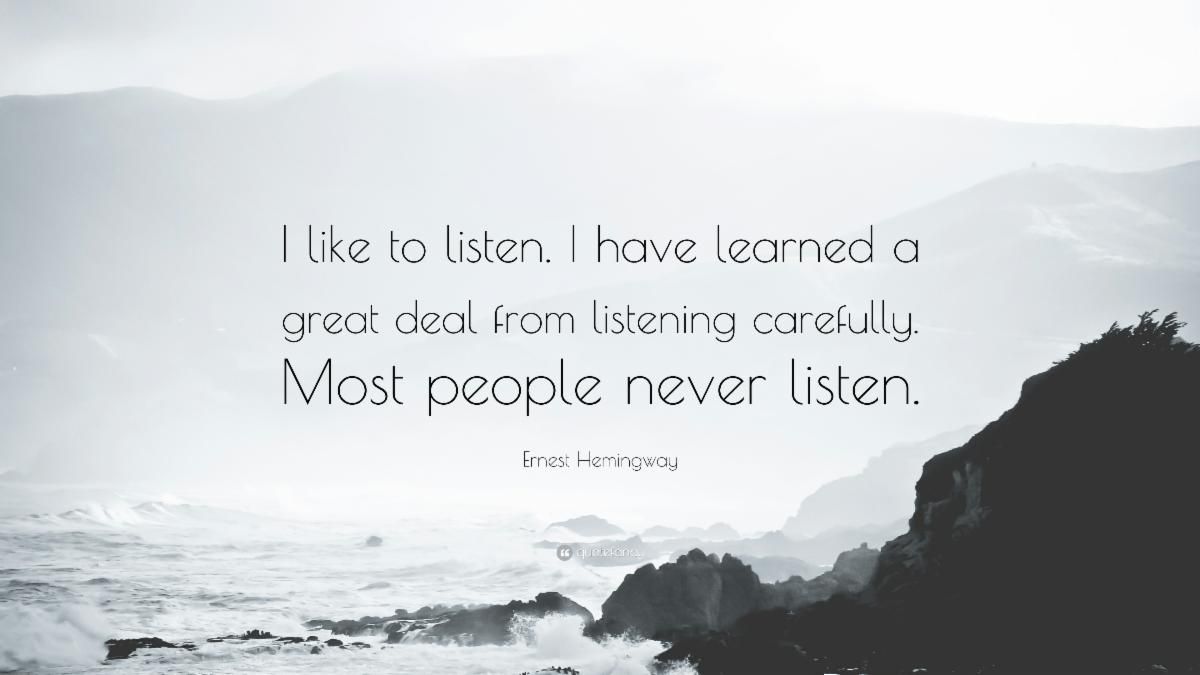
October 1, 2020
Leaders Listen:
As executives, we tend to do a lot of talking. But the wisest executives focus most of their communication energies on the other end of the stick: They don’t just talk; they listen. The best listen very attentively — not just for what's being said, but how it’s said, and even what’s not being said. Listening well may seem like the oldest piece of advice in the management book, but it continues to ring true: Plenty of leaders do a poor job of listening.
But strong leaders listen, and they listen well.
For most executives, time is in short supply and we feel we just aren’t able to have lengthy conversations with all our team members. Fair enough. But there is a solution: Make the most of the opportunities you do have by listening strategically. The idea of active listening has been around for decades, but it’s very difficult to do with a lot on your mind because it requires deep concentration. And let’s face it, it’s easy to get lazy and let someone talk on and on without clarifying an idea because our mind is wandering, too. But that provides little value either way. With focus and concentration, a three-minute conversation can yield stronger connection than an hour of partial attention while multitasking. It can be tremendously worthwhile to take a few moments to really connect with the people around us.
How do you maximize your ability to listen? Here are my go-to strategies:
- Make a personal connection. People aren’t task-focused robots. Having some kind of human connection is important. Doing so regularly is also what allows you to get right to business when you only have a few minutes.
- Stop what you’re doing. Show people in your organization that you value them by conversing them and them alone. Active listening does not allow for multitasking.
- Make eye contact. When you look at someone’s face while you talk to them, you see beyond the words to the emotion and deeper understanding. That’s why I’ve always preferred videoconferencing, even before the pandemic!
- Clarify and confirm. It may sound odd, but you can use your verbal skills to help you listen. Sometimes people take tangents, speak in unclear or equivocal terms, or cover many topics at once. Get involved in the conversation by asking clarifying questions to help you understand or confirm what you are being told.
- Consider the tone and tenor. As important as understanding the content or ideas is understanding the underlying messages that are conveyed with emotions. Make sure you stay attuned to these, as they’ll give you clues about what is really important.
- Wait them out. Silence can feel uncomfortable, but when we can withstand a long pause to allow someone to formulate a complete thought, the conversation can reach new depths, which can be very rewarding. A pleasant, non-judgmental look goes a long way toward making a pause more bearable. And you may find that you learn even more with what is said after you pause!
Chances are the people in your organization have good ideas for streamlining a portion of your operation, or for eliminating wasted time or material, or for efficiencies of many other kinds. A few minutes spent on listening can be money in the bank.
It seems so obvious, doesn’t it? Listen with focused attention. Note the subtleties and nuances in a conversation. Yet so few leaders do it consistently well. Use these approaches each day, multiple times each day, and unlock an important key to inspiring and motivating others to high performance.
Current Read:
A whopping 52 percent of voluntarily departing employees say that their company could have done something to keep them — and that hurts, to the tune of $1 trillion per year. That’s what Shane McFeely and Ben Wigert say in their Gallup Workplace article of March 13, 2019: “This Fixable Problem Costs U.S. Businesses $1 Trillion.” The authors report that the cost of replacing an individual employee can run from one-half to two times the employee’s annual salary. Of course, when people leave a business voluntarily, who leaves — top performers or weak ones? It’s usually top or at least good performers, which makes the loss especially difficult. For some employees, their departures were for reasons as simple as not being consulted about their level of job satisfaction or their future with the organization. Something to think about ….
You can read the article here.
Quotable:


